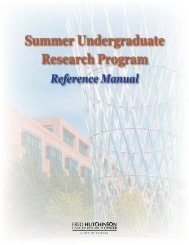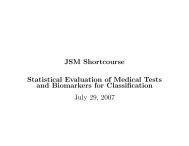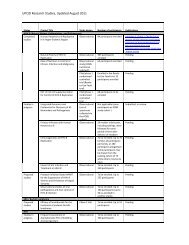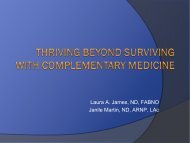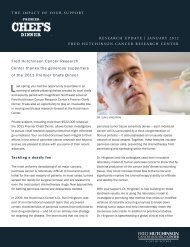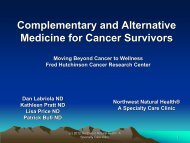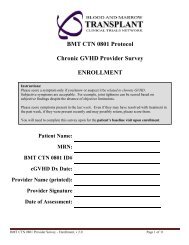discovery - Fred Hutchinson Cancer Research Center
discovery - Fred Hutchinson Cancer Research Center
discovery - Fred Hutchinson Cancer Research Center
Create successful ePaper yourself
Turn your PDF publications into a flip-book with our unique Google optimized e-Paper software.
M. Elizabeth Halloran, M.D., D.Sc.<br />
Ira Longini, Ph.D.<br />
Biostatisticians<br />
PREDICTING THE SPREAD OF INFECTIOUS DISEASES<br />
When the World Health Organization declared smallpox<br />
eradicated in 1980, there was a giddy overconfidence<br />
that the deadly struggle against the microbial world was ending.<br />
“There was this feeling that we had won the battle against<br />
infectious diseases,” said Dr. Elizabeth Halloran, who studied<br />
tropical diseases in the early 1980s, when there was waning<br />
interest in the topic.<br />
Halloran was not convinced microbes had been subdued,<br />
much less conquered. Nor was Dr. Ira Longini, whose travels<br />
through Latin America brought him face to face with tuberculosis,<br />
syphilis and other infectious<br />
diseases that were presumably under<br />
control.<br />
With research funding and drug<br />
development for such diseases in<br />
full retreat at the time, Halloran and<br />
Longini forged paths in the field of<br />
biomathematics and biostatistics to<br />
study the spread of infectious diseases.<br />
Now, as collaborators, they’re among<br />
the world’s leaders in the field, their<br />
expertise sought widely in the struggle<br />
against new and resurgent infectious diseases. During the last<br />
year, they have consulted with federal and state officials and<br />
have been consulted by world health organizations to help<br />
develop intervention plans to control potential pandemics, such<br />
as avian flu.<br />
Today, the threat of a pandemic flu with the potential to<br />
kill tens of millions is a top concern of public health officials<br />
worldwide. HIV, malaria and tuberculosis kill as many as<br />
6 million people each year. Tuberculosis alone is expected to<br />
infect as many as 1 billion people in the next 20 years.<br />
Small as they are, microbes make up 60 percent of the<br />
planet’s biomass. With so many microbes out there, “We’re<br />
EVERY FEW DECADES, THE INFLUENZA VIRUS TRIGGERS MISERY THROUGHOUT THE WORLD.<br />
further away than ever from closing the book on infectious<br />
diseases,” the Infectious Diseases Society of America declared<br />
last year.<br />
It’s within this context that Halloran and Longini collaborate<br />
to create mathematical models that predict the spread of<br />
disease and simulate intervention strategies to save lives.<br />
Using powerful computers to track the potential path of<br />
infectious diseases, the duo believe their mathematical models<br />
could help save the lives of hundreds of millions of people,<br />
particularly against pandemic flu, which unchecked could<br />
spread across the globe in a matter<br />
of months.<br />
Mathematical models allow researchers<br />
to simulate the spread of disease<br />
through different kinds of settings and<br />
test different kinds of intervention. In<br />
one such model, Longini and Halloran<br />
tracked how quickly pandemic flu would<br />
move across the United States if<br />
nothing were done. In a simulated<br />
60 days, the disease had spread to every<br />
corner of the map. The number of dead:<br />
tens of millions. They developed other models to help predict<br />
which interventions—such as vaccination, keeping children out<br />
of schools and asking people to work from home—would most<br />
effectively control spread of the disease and save the most lives.<br />
It’s a scary scenario, but Longini and Halloran believe the<br />
tools are in place to save the world from disaster. And not just<br />
from influenza.<br />
“We hope that the tools we’re developing will be used for all<br />
emerging diseases,” Longini said.<br />
“You can’t control disease but you can intervene to save<br />
lives,” Halloran said. “You can intervene and change the course<br />
of events.’’<br />
13




